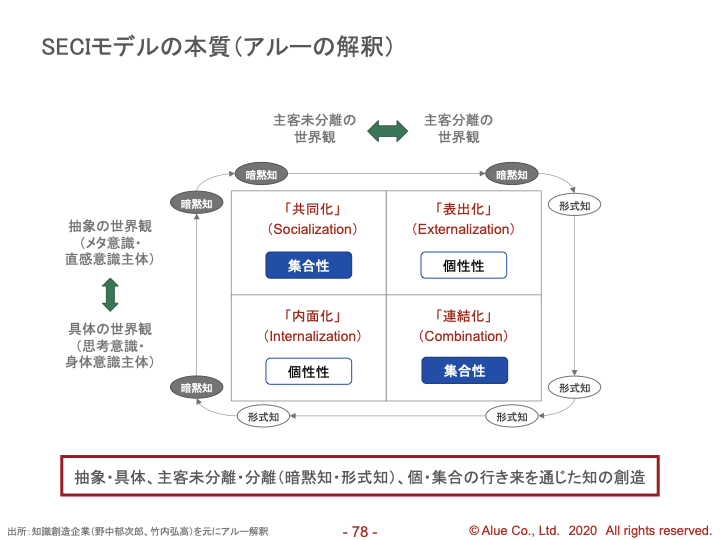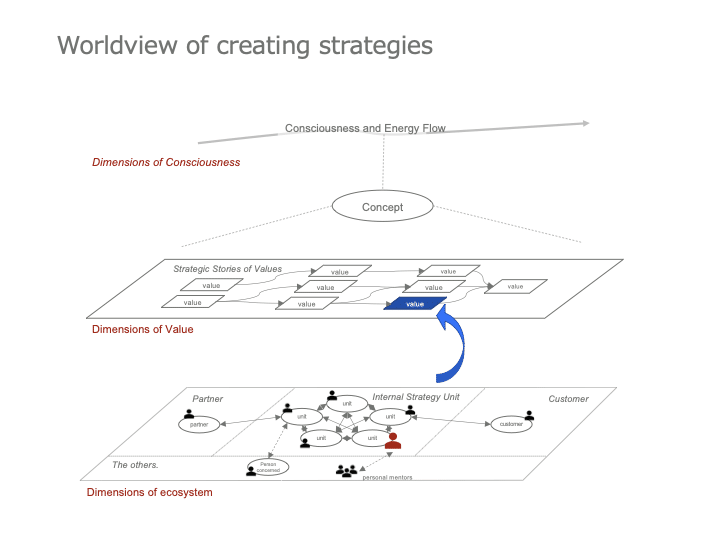
意識の意識化による、戦略ストーリー創出とはどのようなものか?
前回の記事では、価値創造プロセスの最後のプロセスである「戦略の創発」について、意識の意識化の観点から掘り下げてお話ししました。戦略について意識の意識化の観点から紐解く内容としては、これまでの記事でお話してきたもので全体となります。ただ、扱う内容が多岐にわたっていますので、戦略の章の最後の記事として、これまでお話ししてきた内容の全体像を俯瞰しておきたいと思います。
章の全体としては、マクロ的な視点からミクロ的な視点にズームインをするような流れでお話ししてきましたが、この記事においては、その逆でミクロ的な視点から段々とマクロ的な視点にズームアウトする流れでお話ししたいと思います。
ミクロな視点:価値創造プロセスとSECIモデル
前回の記事でお話しした内容は、戦略の創発をテーマとしていました。SECIモデルをご紹介して、戦略の創発においてはSECIモデルがうまく回るように、意識モードを使い分けていくことが大切であることをお伝えしました。

このSECIモデルは、価値創造プロセスの最後のプロセスである「⑥戦略創発」のための自分と周囲の協働プロセスという位置付けでご紹介をしましたが、実は価値創造プロセス全体①〜⑥をSECIモデルに紐づけて捉えることもできます。

前回の記事においては、⑥の戦略の創発においてSECIモデルを回すことが重要であるということをお伝えしていますが、①〜⑤のプロセスについてもSECIモデルの各象限を表していると捉えることができます。
①〜⑤については個人の中の意識プロセスであり、⑥は集団の(あるいは個人と集団の相互作用としての)意識プロセスと見做すことができますが、個人の意識プロセスがあってから集団の協働プロセスがそれに続くというイメージよりは、個人と集団のプロセスは同時並行に進んでいくというイメージに近いです。
これは、SECIモデルにおいて、個人と集団の相互作用によって知識創造されていくことを描写をしていることと整合します。
ここで改めて、価値創造プロセスについての全体像を確認しておきましょう。

戦略ストーリーを構成する一つひとつの価値要素を創出するときには、個人と集団の相互作用をしていく上図のような価値創造プロセスを実践していくことが大切になります。
3+1意識モデルを補助線として、価値創造の各プロセスにおいて、どの意識を活性化するかを意識化していくと効果的です。例えば、①の戦略ストーリーの直感においては、直感意識(+メタ意識)を活性化させる。②のエスノグラフィーにおいては、身体意識を活性化させるという具合です。
メソ(ミクロとマクロの間)の視点:戦略ストーリーを創出するストーリー
これまで、ミクロな視点で、戦略ストーリーにおける価値要素を創出するための価値創造プロセスについてお話ししてきましたが、もう一段、マクロ方向に視点を移していきましょう。

それは、戦略ストーリーを創出するストーリーとしての、「平野モデル」としてご紹介した5つのステップです。平野モデルの中の5つ目の「価値の創造」ステップを詳細化したものが、先ほどご説明した価値創造プロセスです。
逆に言えば、価値創出プロセスの前段階として、平野モデルにある①〜④のステップがあるということですね。ここは、非常に重要なポイントであると個人的に思っています。というのも、「個人と集団の相互作用によって価値創造をしていく」ということは、戦略ストーリー創出の一歩目ではないからです。
いきなり価値創造しようとしても、うまくいきません。そこには、自分自身の内なるエネルギーと、それに共感してくれる仲間がないからです。具材もないし、食べてくれるお客様もいないのに、美味しい料理をたくさん作ろうとしているようなものです。
ここは、どれほど強調しても強調しすぎることはできないくらいに大切です。戦略を考えるときに、市場環境や競合状況を調査して、戦略立案しようとする場面を見かけることがあります。これも、いきなり価値創造しようとする誤りの1つの典型と思います。
冒頭にお話しした価値創出プロセスは、この観点からすると「全体の一部」にしか過ぎません。
個人が自らの主体的真理に気づき、心を開くことからスタートし、その主体的真理を発信します。そこに惹かれて集まってきた人々のエコシステム的な集団から仲間と顧客が生まれます。そこで、互いの個性化のストーリーをお互い憑依するかのように共有し合うことで、戦略ストーリーが生まれてくる土壌が整っていきます。

このような土壌があってこそ、戦略ストーリー上の価値要素が、個人と集団の相互作用の中で、価値創出プロセスを経ながら生み出されていくのです。
このような土壌をつくる上で、もっとも大切なことは何でしょうか?
それは、「主体的真理とのつながり」から始めることでした。戦略ストーリーづくりの始まりは、個人の主体的真理です。主体的真理とは、「自分にとって生きがいとなる理想、自分固有の生きる目的」という意味で、私が最も大切にしているキーワードの一つです。

マクロの視点:3つの次元で捉える
これまで、ミクロな視点としての価値創出プロセス、メソ(ミクロとマクロの間)の視点としての平野モデルについてお話ししてきましたが、マクロな視点に移っていきましょう。

もっともマクロな視点でいえば、戦略ストーリーの創出は3つの次元の間の相互作用として捉えることができます。
一つは価値の次元であり、私たちが通常、戦略を語るときに想定している次元です。もう一つは、エコシステムの次元であり「ヒト全般」のつながりや働きかけを表します。3つ目の次元は、意識の次元です。これは、主体的真理や、世の中の意識の流れなど、まだ価値として具現化されていない、ヒトの意識を記述する次元です。
意識は現象の根源です。ヒトの意識がヒトの言動に影響を与え、ヒトの言動がコトを生み出します。その意味では、意識の次元がもっとも根源的な次元であると言えます。
このマクロな視点と平野モデルの関係は、平野モデルは、このマクロの3つの次元を行き来しながら価値創出をしていくステップを記述していると捉えることができます。

経営戦略に関する書籍はたくさんありますが、その多くは、価値の次元の話をしていることが多いと思います。価値の次元の話ももちろん大切ですが、それに閉じてしまうと大切なもの、本質的なものを見落としてしまうリスクがあると思っています。
その典型的な例が、戦略においてはヒトよりもコトが優先されるという誤解や、戦略は市場分析から始まるという誤解ではないでしょうか。
一方で、価値の次元が大切ではないという話でもありません。価値の次元において、顧客価値と、競合との差別化を両立することは、継続的な利益創出、持続的な成長のために不可欠です。
価値の次元において、顧客価値と競合との差別化を両立するために、静止画的な戦略ではなく、動画的なストーリー戦略を描いていくという話がありました。

レベル1やレベル2だけの競争優位ではなく、レベル3やレベル4の動画的な戦略ストーリーとしての差別化ができると、顧客価値も高まり、競合との差別化も強固になります。
ただし、これらの価値創出や差別化は、あくまでも「結果としてそうなる」ということであり、この結果を追い求めているだけでは、それは実現しないということに注意する必要があります。
このような価値創出や差別化を実現するためにも、平野モデルで表現されているように主体的真理が始まり、周囲の共感を得ていくステップを経て、個人と集団が相互作用する価値創出プロセスを踏んでいくことが大切になります。
戦略ストーリー作りの全体像
これまでお話ししてきた内容を1枚の図にまとめると以下のようになります。これまで、本章でお話ししてきた内容をご理解いただいている皆様であれば、この図が表現している全体感・丸ごと感をお感じいただけるのではないでしょうか。

この記事で、戦略をテーマとした本章は以上となります。次の記事からは、「改善・イノベーション」をテーマとして意識の意識化の観点からお話ししたいと思います。
本日の問いとなります。(よろしければ、コメントにご意見ください)
・あなたが所属している、あるいは関わっているチームや組織の経営戦略を思い浮かべてください。この記事でお話した戦略ストーリーの全体像(マクロ・メソ・ミクロの視点の全て)を補助線として、あなたのチームや組織の経営戦略をみたときに、どのようなことに気づきますか?
・いい戦略ストーリーを創出するために、あなたは意識の意識化をどのように実践すると良さそうでしょうか?
What is strategy story creation through ISHIKI(consciousness) management?
In the previous article, I talked about the last process of the value creation process, "Co-creation of strategies," in depth from the perspective of consciousness management. As for the content of strategy from the perspective of consciousness management, what I have discussed in the previous articles is the whole. However, because of the wide range of topics covered, I would like to give a general overview of what we have talked about so far as the last article in the chapter on strategy.
The entire chapter has been described as zooming in from a macro perspective to a micro perspective. In this article, I would like to describe the opposite flow, zooming out from a micro perspective to a macro perspective.
Micro Perspective: Value Creation Process and SECI Model
In my last article, I talked about the theme of strategy co-creation/emergence, introducing the SECI model and the importance of using different modes of consciousness in strategy co-creation/emergence so that the SECI model can run successfully.

I introduced the SECI model as a collaborative process between oneself and others for the last process of the value creation process, but in fact, the entire value creation process (1) to (6) can be linked to the SECI model.

In my previous article, I mentioned that it is important to apply the SECI model to the strategy co-creation/emergence (6), but the processes (1) through (5) can also be viewed as representing each quadrant of the SECI model.
While (1) through (5) can be regarded as consciousness processes within the individual, and (6) as consciousness processes in a group ( or as interaction between individuals and groups), it is closer to the image that individual and group processes proceed in parallel, rather than the image that there is an individual consciousness process followed by a group collaborative process.
This is consistent with the SECI model, which describes knowledge creation through the interaction of individuals and groups.
Let's take a look again at the overall picture of the value creation process.

When creating each of the value elements that make up a strategy story, it is important to implement the value creation process shown in the figure above, where individuals and groups interact with each other.
Using the 3+1 consciousness model as an auxiliary line, it is effective to become aware of which consciousness to activate in each process of value creation. For example, in (1) Intuition of a strategy story, we activate the intuitive consciousness (+ meta-consciousness), and in (2) ethnography, activate bodily consciousness.
Meso (between micro and macro) perspective: story to create strategy stories
So far, I have talked about the value creation process for creating value elements in strategy stories from a micro perspective, and let's shift our perspective to a more macro perspective.

It is the five steps that I introduced as the "Hirano Model" as a story for creating strategy stories. The fifth "value creation" step in the Hirano model is the value creation process that I explained earlier in detail.
Conversely, steps (1) through (4) in the Hirano model are the preliminary steps of the value creation process. I personally believe that this is a very important point. This is because "creating value through the interaction of individuals and groups" is not the first step in creating a strategy story.
If we try to create value out of the blue, it won't work. This is because we don't have our own inner energy and colleagues who can empathize with us. It's like trying to make a lot of delicious food without the ingredients nor customers to eat it.
This is so important that I cannot overemphasize how important it is. When thinking about strategy, I sometimes see people trying to plan strategies by studying the market environment and the competitive situation. I think this is also typical of the mistake of trying to create value out of the blue.
The value creation process I mentioned at the beginning of this article is only a part of the whole from this perspective.
It starts with individuals becoming aware of their own subjective truths, opening their hearts, and then transmitting those subjective truths. From this ecosystem-like group of people who are attracted to the subject truth, friends and customers are born. Then, by sharing each other's personalized stories as if they were wearing the other person's shoes, the ground is set for the creation of strategic stories.
Only in this kind of ground can the value elements of the strategic story be created through the value creation process in the interaction between individuals and groups.
What is the most important thing in creating this kind of ground?
It was to begin with the connections to the subjective truth. The beginning of creating a strategy story is an individual's subjective truth. Subjective truth is one of my most important keywords, as it means "An ideal that makes life worth living for us, a purpose for living that is unique to us."

Macro perspective: perceiving in three dimensions
So far, I have talked about the value creation process as a micro perspective, and the "Hirano model" as a meso (between micro and macro) perspective, and let's move on to the macro perspective.

From the most macroscopic perspective, the creation of a strategy story can be seen as an interaction between three dimensions.
The first is the value dimension, which is the dimension we usually assume when we talk about strategy. The second is the ecosystem dimension, which represents the connections and interactions among people in general. The third dimension is the dimension of consciousness, which describes the human consciousness that has not yet been embodied in values, such as subjective truths and the flow of consciousness in the world.
Consciousness is the root of phenomena. Our consciousness influences our words and actions, and our words and actions create things. In this sense, we can say that the dimension of consciousness is the most fundamental dimension.
The relationship between this macro perspective and the Hirano model can be seen as the Hirano model describing the steps of value creation while moving back and forth between these three macro dimensions.
There are many books on management strategy, but I think most of them talk about the value dimension. Of course, it is important to talk about the value dimension, but I believe that if we confine ourselves to that, we run the risk of overlooking what is important and essential.
Typical examples of this are the misconception that things take precedence over people in strategy, and the misconception that strategy begins with market analysis.
On the other hand, I am not saying that the value dimension is not important. In the value dimension, balancing customer value and differentiation from the competition is essential for continuous profit generation and sustainable growth.
In the value dimension, we talked about drawing a dynamic strategy story, rather than a static strategy, in order to realize both customer value and differentiation from the competition.

If we can differentiate ourselves not only as a Level 1 or Level 2 competitive advantage, but also as a Level 3 or Level 4 dynamic strategy story, our customer value will increase and our differentiation from the competition will be stronger.
It is important to note, however, that these value creation and differentiation are only "the result", and simply chasing this result will not make it happen.
In order to realize this kind of value creation and differentiation, it is important to start with subjective truth, as expressed in the Hirano model, and go through the steps of gaining the empathy of the people around us, and then follow a value creation process in which individuals and groups interact with each other.
Overview of strategy story creation
The following figure summarizes what we have discussed so far. If you have understood the contents of this chapter so far, you may feel the sense of wholeness expressed by this figure.

This article concludes this chapter on the theme of strategy. In the next article, I would like to talk about the theme of "improvement and innovation" from the perspective of consciousness management.
.Here are the quests of the day. (If you'd like, please share your thoughts in the comments.)
・Think of the business strategy of a team or organization that you belong to or are involved with. What do you notice when you look at your team's or organization's business strategy with the overall strategic story (all of the macro, meso, and micro perspectives) discussed in this article as an auxiliary line?
・In order to create a good strategy story, how do you think you can implement consciousness management?
Bunshiro Ochiai
この記事が気に入ったらサポートをしてみませんか?
